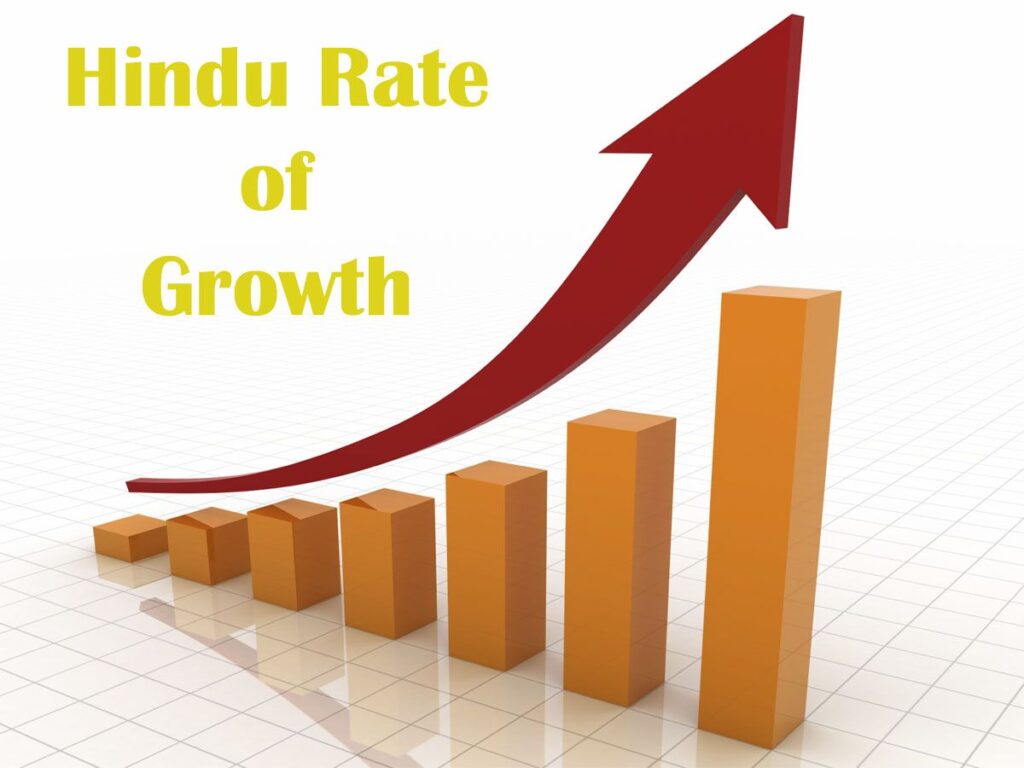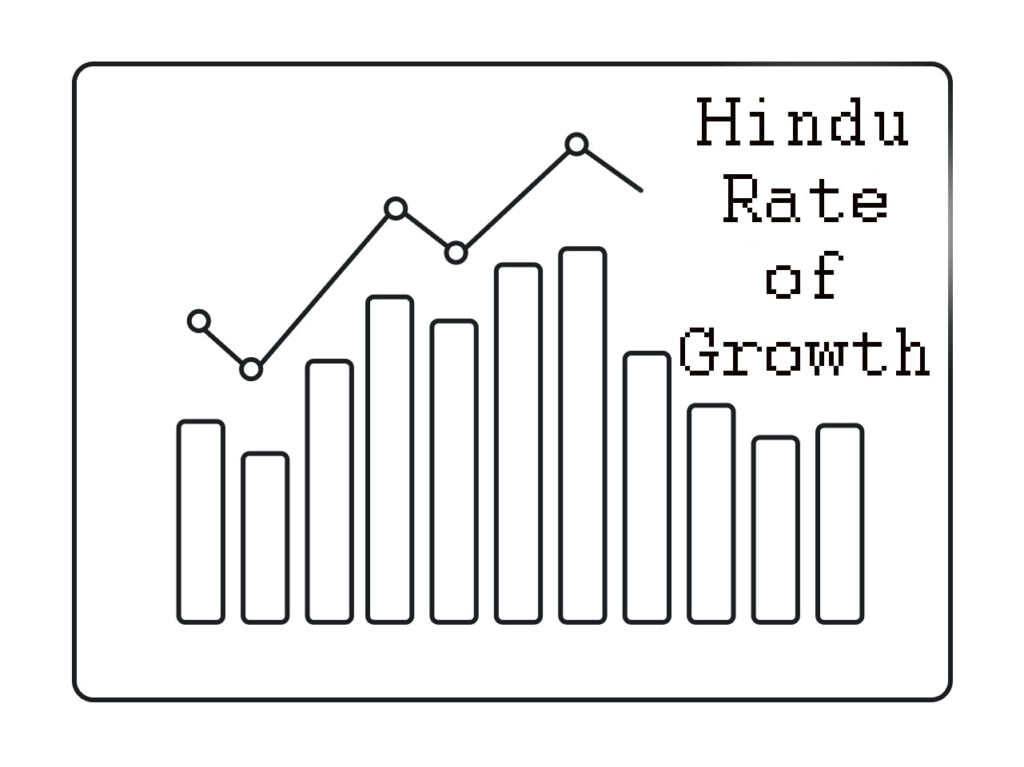Why is it Called the Hindu Rate of Growth?
The term “Hindu Rate of Growth” has become ingrained in economic discussions, particularly in the context of India’s economic development. Coined during the mid-20th century, this term has sparked debates and discussions on the pace of India’s economic growth, its causes, and its implications. This article aims to delve into the origins of the term, the economic context in which it emerged, and the subsequent transformations in India’s economic landscape. Additionally, it will explore whether the term “Hindu Rate of Growth” accurately reflects the dynamics of India’s economic progress.

Contents
Origins of the Term:
The term “Hindu Rate of Growth” was first introduced by economist Raj Krishna in the 1970s. Raj Krishna, an Indian economist and policymaker, used this term to describe the slow and steady growth rate of the Indian economy during the post-independence period. The period in question spans roughly from the late 1940s to the 1980s.
The “Hindu Rate of Growth” label emerged as a result of the prevalent economic conditions in India during this period, characterized by a seemingly sluggish pace of economic growth. The term suggested that India’s growth rate was stuck at a low level, hovering around 3 to 4 percent per annum. The connotation of the term is not religious; rather, it is a reference to the majority religion in India, Hinduism.
Understanding the Economic Context:
To comprehend why the term “Hindu Rate of Growth” gained currency, it is essential to examine the economic conditions prevailing in post-independence India. In the early years after gaining independence in 1947, India adopted a mixed economy model, combining elements of both socialism and capitalism. The government played a central role in planning and controlling various sectors of the economy.
One of the primary features of India’s economic policies during this period was the emphasis on import substitution industrialization (ISI). The objective was to reduce dependence on foreign goods by encouraging the domestic production of goods that were previously imported. While this approach had its merits, it also led to inefficiencies, a lack of competitiveness, and a slow pace of industrialization.
The heavy regulatory framework and bureaucratic controls further stifled economic dynamism. Licensing requirements, restrictions on foreign investment, and a plethora of regulations contributed to a business environment that was not conducive to rapid economic growth. The public sector dominated key industries, and the private sector faced numerous constraints.
Read More>> Significance of Lord Ganesha Idol

Factors Contributing to the “Hindu Rate of Growth”:
Several factors contributed to the stagnation in India’s growth rate during the period associated with the “Hindu Rate of Growth.” These factors include:
- Public Sector Dominance: The dominance of the public sector in key industries led to inefficiencies and a lack of innovation. State-controlled enterprises faced challenges in adapting to market demands and were often plagued by bureaucratic hurdles.
- Bureaucratic Controls and Regulations: The extensive bureaucratic controls and regulatory framework impeded the growth of businesses. Obtaining licenses, complying with regulations, and navigating red tape became significant challenges for entrepreneurs.
- Import Substitution Industrialization (ISI): While ISI aimed to promote self-sufficiency, it also resulted in the development of industries that were not globally competitive. The focus on protecting domestic industries from foreign competition limited the incentive for efficiency and innovation.
- Agricultural Focus: The Indian economy remained predominantly agrarian during this period, with a large population dependent on agriculture. The slow pace of industrialization and modernization in the agricultural sector contributed to economic inertia.
- Low Productivity Growth: Productivity growth, both in agriculture and industry, was sluggish. This was partly due to inadequate technological advancements, lack of skilled labor, and a general resistance to change.
- Limited Foreign Direct Investment (FDI): The restrictive policies towards foreign investment limited the flow of capital and technology into the country. This hindered the integration of the Indian economy with global markets.
Read More>> Significance of OM Symbol | AUM Symbol

Reforms and Economic Transformation:
The label “Hindu Rate of Growth” began to lose its relevance in the 1990s when India embarked on a series of economic reforms aimed at liberalizing and opening up the economy. The landmark economic reforms of 1991 marked a departure from the earlier policies and laid the foundation for a more market-oriented approach. The key elements of these reforms included:
- Liberalization: The government initiated measures to liberalize various sectors of the economy, reducing the role of the state and promoting market forces. Trade barriers were dismantled, and licensing requirements were eased.
- Privatization: The privatization of state-owned enterprises gained momentum, allowing for greater efficiency and competitiveness. Private participation in sectors such as telecommunications, aviation, and infrastructure was encouraged.
- Globalization: India embraced globalization by integrating with the global economy. This involved opening up to foreign trade, encouraging foreign direct investment, and participating actively in international markets.
- Financial Sector Reforms: Reforms in the financial sector aimed at enhancing efficiency, transparency, and competition. Banking sector reforms, including the introduction of new financial instruments, contributed to the development of a more robust financial system.
- Technological Advancements: The information technology (IT) revolution played a pivotal role in India’s economic transformation. The growth of the IT and software services sector propelled India onto the global stage as a major player in the knowledge economy.
Read More>> 3000yr Old Poombarai Murugan Temple
Impact of Reforms on Growth:
The economic reforms initiated in the 1990s had a profound impact on India’s growth trajectory. The country witnessed a significant acceleration in economic growth, breaking away from the earlier perceived “Hindu Rate of Growth.” Several factors contributed to the newfound momentum:
- Higher Productivity: With the liberalization of the economy, industries became more competitive and efficient. The removal of bureaucratic hurdles and the infusion of private capital led to increased productivity across sectors.
- Foreign Direct Investment (FDI): Opening up the economy to foreign investment attracted capital, technology, and expertise. Increased FDI inflows contributed to the modernization and expansion of various industries.
- Global Competitiveness: The shift towards a market-oriented economy enabled Indian businesses to compete globally. Industries such as information technology, pharmaceuticals, and automotive became internationally competitive.
- Infrastructure Development: The focus on infrastructure development, including transportation, communication, and power, created a more conducive environment for business growth.
- Entrepreneurship and Innovation: The liberalized environment fostered entrepreneurship and innovation. New businesses emerged, and existing ones were able to adapt more readily to changing market conditions.
- Services Sector Boom: The services sector, particularly IT and business process outsourcing (BPO), experienced a boom, contributing significantly to economic growth and employment generation.
Challenges and Criticisms:
While the economic reforms have undoubtedly brought about positive changes, challenges and criticisms persist. Some of the issues include:
- Income Inequality: Despite economic growth, income inequality has been a concern. The benefits of growth have not been uniformly distributed, leading to disparities between different sections of society.
- Jobless Growth: There have been concerns about the quality of employment generated, with a significant portion of the workforce engaged in
FAQ:
What factors contributed to Hindu Rate of Growth (HRG)?
- Economic liberalization: Policy reforms like deregulation, privatization, and trade liberalization opened up the Indian economy and attracted foreign investment.
- Focus on manufacturing and services: Increased emphasis on industries like IT, pharmaceuticals, and automobiles along with expanding service sectors like banking and tourism boosted growth.
- Improved infrastructure: Investments in roads, ports, and power grids facilitated better connectivity and supported business activity.
- Demographic dividend: India’s young and growing population provided a large workforce and consumer base, fueling economic activity.
What were the impacts of Hindu Rate of Growth (HRG)?
- Poverty reduction: India witnessed a significant decline in poverty rates during this period, with millions lifted out of poverty.
- Improved living standards: Increased incomes led to better access to education, healthcare, and other essential services.
- Job creation: Rapid economic growth generated millions of new jobs, particularly in urban areas.
- Global recognition: India emerged as a major player in the global economy, attracting foreign investment and trade partnerships.
What are the challenges and limitations of Hindu Rate of Growth (HRG)?
- Inequality: While overall growth was impressive, the benefits were not evenly distributed, leading to widening income inequality and wealth gaps.
- Rural-urban divide: The growth was concentrated in urban areas, leaving rural communities lagging behind in terms of development and infrastructure.
- Environmental concerns: Rapid industrialization and urbanization put pressure on India’s natural resources and led to environmental degradation.
- Sustainability: The long-term sustainability of HRG was questioned due to its dependence on external factors like foreign investment and global commodity prices.
What is the future of India’s economic growth?
While the Hindu Rate of Growth (HRG) era has ended, India continues to be one of the fastest-growing economies in the world. The future of its economic growth will depend on factors like:
- Continued economic reforms: Maintaining a positive policy environment that attracts investment and fosters innovation.
- Addressing inequality: Implementing policies that provide equal opportunities and distribute the benefits of growth more equitably.
- Investing in infrastructure and education: Upgrading infrastructure and ensuring quality education to equip the workforce for future challenges.
- Sustainable development: Balancing economic growth with environmental protection and ensuring social inclusivity.
